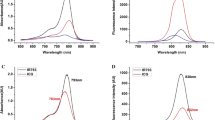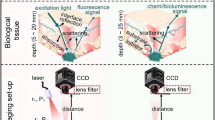Abstract
IR-780, a novel near-infrared (NIR) fluorescent probe, was synthesized and applied to living cells. The probe exhibited good fluorescent characteristic, and cell experiments showed the probe had high affinity and without apparent cytotoxicity. Fluorescent image experiments in living A549 (Human lung adenocarcinoma epithelial cell line) and L929 (mouse fibroblast cell line) cells, further demonstrated its potential applications in biological systems. The probe effectively prevented the influence of autofluorescence and native cellular species in biological systems. It also exhibited excellent cell membrane permeability, good photostability, and high sensitivity.
Similar content being viewed by others
Avoid common mistakes on your manuscript.
Introduction
Biomedical optical imaging is a rapidly expanding field with direct applications in cellular biology, pharmacology, and disease diagnosis [1]. Fluorescence imaging is an optical imaging technique that is useful for biological imaging without the complications that often accompany the use of nuclear contrast agents [2]. Near-infrared (NIR) fluorescent dyes have widely used as fluorescence probes, due to their maximum absorption peak is greater than 650 nm where a biologiacal matrix exhibits the least absorption and autofluorescence background, improving the detection sensitivity and selectivity, also can reduce the life body damage, conducive to the realization of the living detection. Near-infrared fluorescent dyes have been widely used in biomolecular analysis field [3]. Near-infrared fluorescence imaging, in particular, provides many advantages as a noninvasive technique for real-time in vivo monitoring of biological information in living subjects without the use of ionizing radiation [4]. The development of NIR dyes as fluorescence labels and sensors has attracted increasing interest over the last decade because of their potential to advance and facilitate optical imaging translation to humans. NIR fluorescence imaging has great potential for probing molecular markers associated with tumor proliferation, growth, and metastasis [5, 6]. Cyanine dye is a commercially available near-infrared fluorescent dye, its spectral range is in the near infrared region, in this spectrum, absorption or fluorescence intensity of biological sample is very small, so applied cyanine dye to image living body can reduce background interference. Compared with other dyes, NIR fluorescent probes have the following advantages: NIR light is poorly absorbed, background autofluorescence is negligible, and light scattering in tissue is relatively low. Indocyanine green (ICG) is a widely used organic dye in optical imaging. This dye is approved for human use by the US FDA. For this reason, many research groups are focusing on the synthesis of ICG derivatives for in vivo imaging [7, 8]. However, ICG applications are mitigated by several limitations, including low quantum yield, optical instability in the body, and unrestrained leakage in blood vessels. Indol heptamethine fluorescent probes which are representative of cyanine dyes are consisted of indol heterocycle, heptamethine, and N-substituted side chains. They are widely used for targeted cancer therapy, labeling protein, and detecting of metal cations and other biological aspects because of their excellent photophysical properties like good solubility, tunable maximum absorption wavelength, and large molar extinction coefficient. Based on the structure of indol heptamethine, introducing reactive groups to the parent compounds or changing their structures can make fluorescent probes have different functions like labeling protein and tumor, detecting intracellular metal cations, which has become the hotspot in the field of fluorescence imaging of biological research [9].
Therefore, in this paper, we have synthesized a variety of ICG derivatives in our laboratory and developed different types of NIR imaging systems for noninvasive in vivo imaging research. Our strategy for designing a novel near-infrared fluorescent probe is based on the optical instability in the body, as it affects NIR imaging of biological systems. Bearing these points in mind, we synthesized a near-infrared fluorescent probe that could provide better water solubility when they were applied to cellular analysis in an aqueous environment. We chose tricarbocyanine (Cy), a near-infrared fluorescent dye with high extinction coefficients, as the fluorophore that could provide good photostability when they were applied to biological systems.
Materials and Methods
Apparatus and Materials
1H NMR data were recorded on 300 MHz spectrometers at ambient temperature in DMSO-d 6 and referenced to tetramethylsilane as an internal standard. A Q-TOF Micro Mass Spectrometer was used to identify the products. Absorption spectra were obtained using a pharmaspec UV-visible spectrophotometer. Fluorescence spectra were recorded on the spectrofluorometer. Fluorescent images were obtained using a Nikon confocal laser-scanning microscope (Nikon Corporation, Japan) with an objective lens. Compounds IR-820 and 3-aminophenol were synthesized in our laboratory. 3-(4,5-Dimethylthiazol-2-yl)-2,5-diphenyltetrazolium bromide (MTT) was purchased from Sigma-Aldrich Co. A549 (human lung adenocarcinoma epithelial cell line) and L929 (mouse fibroblast cell line) cells were purchased from the American Type Culture Collection. All reagents and solvents were commercially available and used without further purification, unless otherwise indicated.
Synthesis and Characterization of IR-780
Figure 1 shows the synthetic route of the designed heptamethine cyanine dye IR-780. Compound IR-820 (848 mg, 0. 1 mmol) was dissolved in DMF (30 mL), and then 3-aminophenol (109 mg, 1 mmol) was added. The solution was stirred under nitrogen at 80 °C for 2 h and then concentrated under vacuum. The residue was subjected to column chromatography on silica gel by using CH3OH/CH2Cl2 (1:7.5 v/v) as an eluent, affording sensor IR-780 (30.3 mg, 32.9 %) as a dark blue solid. 1H NMR (300 MHz, DMSO-d6), δ 1.25 (m, 10H); 1.64 (s, 12H); 2.50 (t, J = 6 Hz, 4H); 2.67 (m, 4H); 3.33 (s, 1H); 4.19 (m, 4H); 6.16 (d, J = 14 Hz, 2H); 6.49–8.00 (m, 16H); 8.10 (d, J = 12Hz, 2H) and TOF MS (ES−) calculated for C52H56N3NaO7S2 [M-Na+]−, 898.3, found the following: 898.3 (1H NMR and MS spectra of IR-780; see Fig. 2).
Absorption Analysis
Absorption spectra were obtained using a UV-visible spectrophotometer. Probe IR-780 (0.10 ml, 0.10 mM) was added to the 10.0-ml color comparison tubes. After dilution to 1.0 μM with 50 mM PBS at pH 7.4, the mixture was equilibrated for 3 min prior to measurement. All experiments were performed in the presence of 0.10 M NaCl to maintain a constant ionic strength.
Fluorescence Analysis
Fluorescence spectra were recorded using the spectrofluorometer. Probe IR-780 (0.10 ml, 0.10 mM) was added into the 10.0-ml color comparison tubes. After dilution to 1.0 μM with 50 mM PBS at pH 7.4, the mixture was equilibrated for 3 min before measurement. Fluorescence intensity was measured at s ex = 828 nm. All experiments were conducted in the presence of 0.10 M NaCl to maintain a constant ionic strength.
MTT Assay
L929 cells were seeded in 96-well plates at 5000 cells/well. After an overnight culture, the medium in each well was replaced by fresh medium containing different concentrations of IR-780. Each well was treated for 24 h, and 10 μl of MTT solution (5 mg/ml in PBS) was added. The remaining MTT solution was removed after 4 h, and 100 μl of DMSO was added into each well to dissolve the formazan crystals. After 6 h incubation at 37 °C, the absorbance of each well at 490 nm was recorded by a plate reader (Perkin-Elmer Victor3TM) [10].
Confocal Imaging
Fluorescent images were observed using a Nikon confocal laser-scanning microscope (Nikon Corporation, Japan) with an objective lens (×10). The excitation wavelength was 780 nm. The medium was removed prior to cell imaging. Confocal imaging was performed after the cells were washed thrice with PBS (0.10 M).
Results and Discussion
Absorption and Fluorescence Spectra of IR-780
The absorption and fluorescence spectral property of IR-780 were examined in buffered aqueous solution (50 mM PBS, IR-780 1.0 μM, pH 7.4) with 5 % DMSO as a cosolvent. Figure 3a shows that the absorption of IR-780 was 780 nm, which exhibits a strong blue excitation peak at a neutral pH. The fluorescence of IR-780 was 828 nm, which emits a strong emission peak at a neutral pH (Fig. 3b).
MTT Assay
Biocompatibility is always the first property to consider when using a probe in living cells [11]. MTT assay was conducted to evaluate IR-780 cytotoxicity on L929 cells with probe concentrations from 0.1 μM to 10.0 mM. The results showed that cell viability was not significantly affected even when IR-780 concentration as high as 157 μM was used in the culture medium. The probe concentration with good cell viability was later used for in vivo imaging (1 μM).
Fluorescent Confocal Microscopy Image
Finally, we applied IR-780 to A549 and L929 cells to investigate its applicability in biological systems. Confocal fluorescence images of 1 μM IR-780 were obtained in Dulbecco’s modified Eagle’s medium (DMEM) containing 0.1 % DMSO and 10 % fetal bovine serum as a co-solvent. The DMSO stock solution of IR-780 was first dissolved in DMEM, and confocal fluorescence images of A549 and L929 cells were measured. The cells were incubated with IR-780 at pH 7.40 and washed thrice with PBS buffer (0.1 M). The total time of fluorescence stability was 10 min. We examined the effects on A549 and L929 cells. The distribution of the probe within the cells was observed under a fluorescence microscope following excitation at 780 nm. Studies have shown that the IR-780 had excellent membrane permeability and good photostability (Fig. 4).
Conclusion
In this study, a novel near infrared fluorescent probe, IR-780, was synthesized and characterized for in vivo imaging of living cells. The probe exhibited stronger excitation and emission characteristics. The low toxicity of IR-780 on normal cells was verified by MTT assay. The probe effectively prevented the influence of autofluorescence in biological systems and exhibited positive results when tested at a near neutral pH both in aqueous solution and in living cells. The results demonstrated that IR-780 was based on a PET mechanism, and the IR-780 value was obtained by monitoring the intracellular environment of A549 and L929 cells. Therefore, IR-780 has great potential in the investigation of a pivotal function in a biological context through direct intracellular imaging. This simple, sensitive NIR fluorescent probe will be of great benefit to biomedical researchers on biological systems. Efforts to utilize the probe for biological imaging application are in progress.
References
Keramidas, M., Josserand, V., Righini, C. A., et al. (2010). British Journal of Surgery, 97, 737–743.
Hilderbrand, S. A., & Weissleder, R. (2010). Current Opinion in Chemical Biology, 14, 71e9.
Ogawa, M., Regino, C. A., Choyke, P. L., & Kobayashi, H. (2009). Molecular Cancer Therapeutics, 8, 232–239.
Hsu, A. R., Hou, L. C., Veeravagu, A., et al. (2006). Molecular Imaging & Biology, 8, 315–323.
Keramidas, R., Tung, C. H., Mahmood, U., & Bogdanov, A., Jr. (1999). Biotechnology, 17, 375–378.
Ogawa, M., Regino, C. A., Choyke, P. L., & Kobayashi, H. (2009). Molecular Cancer Therapeutics, 8, 232–239.
Bjornsson, O. G., Murphy, R., & Chadwick, V. S. (1982). Experientia, 38, 1441–1442.
Xiao, W., Yao, N., Peng, L., Liu, R., & Lam, K. S. (2009). European Journal of Nuclear Medicine and Molecular Imaging, 36, 94–103.
Tang, B., Liu, X., Xu, K., Huang, H., Yang, G., & An, L. (2007). Chemical Communications, 36, 3726–3728.
Huber, W., & Koella, J. C. (1993). Acta Tropica, 55, 257–261.
Seidl, K., & Zinkernagel, A. S. (2013). Journal of Microbiological Methods, 92, 307–309.
Acknowledgments
This work is supported by the National Basic Research Program of People’s Republic of China (No. 2011CB933503), Technology Supporting Program of Jiangsu province (BE2012657) and the Fundamental Research Funds for the Central Universities (2242014R30019).
Author information
Authors and Affiliations
Corresponding author
Rights and permissions
About this article
Cite this article
Sun, C., Cai, J., Chen, J. et al. The Synthesis of a Novel Near-Infrared Fluorescent Probe and its Application in Imaging of Living Cells. Appl Biochem Biotechnol 175, 1644–1650 (2015). https://doi.org/10.1007/s12010-014-1398-9
Received:
Accepted:
Published:
Issue Date:
DOI: https://doi.org/10.1007/s12010-014-1398-9








